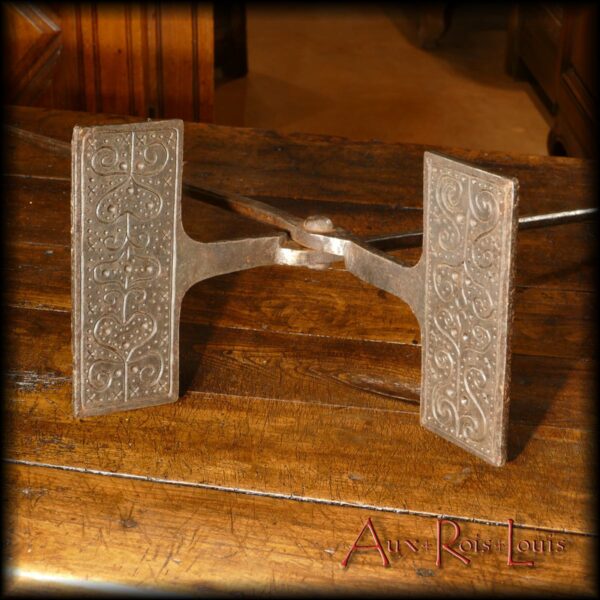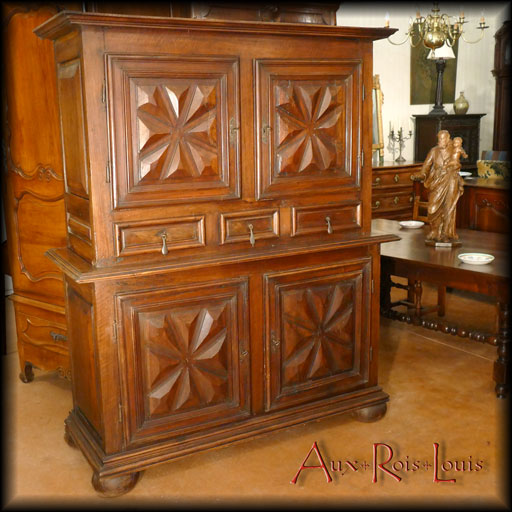Knight’s Oak Armour Chest – 15th Century – High Middle Ages – Périgord – [ME148]
AUX-ROIS-LOUIS’S TREASURES FILMING AT CHÂTEAU DE BIRON IN PÉRIGORD FOR THE SERIES ‘FORTUNE DE FRANCE’ Adapted from Robert Merle’s literary fresco, a writer native to Sarlat, the “Fortune de France” series directed by Christopher Thomson took up residence at Château de Biron, seat of one of the oldest baronies in Périgord, in spring 2023. It…

![Knight’s Oak Armour Chest – 15th Century – High Middle Ages – Périgord – [ME148] Impressive in size, this oak chest comes from a fortress in Périgord. It remains a testament to its past grandeur. Its mission was, in its time, to welcome back from battles the weapons and armour of the Knight Master of the house. It is rare to be able to observe this type of castle furniture, as very few of its comrades-in-arms were produced and most have now disappeared.](https://www.aux-rois-louis.com/wp-content/uploads/2024/04/ME148_P1680364-600x600.webp)
![Royal Cast Iron Fireplace Plate – 17th Century – Périgord – [ME113] Impressively sized, this fireplace plate from the renowned foundries of Périgord showcases traditional royal heraldry, featuring a crown surrounded by fleur-de-lis and pine cones, symbolizing longevity. Cast in 1644, the inclusion of this date in its design adds to its historical appeal and authenticity.](https://www.aux-rois-louis.com/wp-content/uploads/2023/09/ME113_plaque_de_cheminee-600x600.webp)
![Louis XIII style walnut reception table – 19th century – Périgord – [ME092] Louis XIII style walnut reception table – 19th century – Périgord – [ME092]](https://www.aux-rois-louis.com/wp-content/uploads/2022/12/ME092_491-600x600.webp)
![Walnut drop-leaf writing desk – 18th century – Périgord – [ME090] Drop-leaf secretary made in Périgord in the 18th century in beautiful walnut boards. It is composed of a crossbow chest of drawers with two large drawers, surmounted by a sloping flap that opens to become a writing desk.](https://www.aux-rois-louis.com/wp-content/uploads/2022/12/ME090_P1660457b-600x600.webp)
![Chest of Maison Forte in blond walnut – 17th century – Périgord – [ME078] Chest in blond walnut from the 17th century, from a Maison Forte du Périgord. It is decorated with a succession of eight projecting double tables or "chocolate plates", a typical Louis XIII motif. These motifs carved in the mass are two in number on each side and four on the front.](https://www.aux-rois-louis.com/wp-content/uploads/2022/09/ME078_P1660152-600x600.webp)
![Country chest of drawers in cherry wood – 18ᵗʰ century – Périgord – [ME080] Chest of drawers in cherry wood with four drawers on its curved front, two large at the bottom and two smaller at the top placed side by side. It was made in Périgord in the 18th century in thick cherry boards and rests on two scrolled legs at the front and two straight legs at the back.](https://www.aux-rois-louis.com/wp-content/uploads/2022/09/ME080_P1660186-600x600.webp)
![Chest of Knight in walnut – 18ᵗʰ century – Périgord – [ME081] Large walnut chest with straight lines ordered and shaped in the County of Périgord in the 18th century. This geographical origin is attested by a typically Périgord motif of an inverted V which houses the keyhole. The ironwork, lock, hinges and handles are all original.](https://www.aux-rois-louis.com/wp-content/uploads/2022/08/ME081_253-600x600.webp)
![Walnut bonnetière – Louis XIV – 17ᵗʰ century – Périgord – [ME082] Walnut bonnetière – Louis XIV – 17ᵗʰ century – Périgord – [ME082]](https://www.aux-rois-louis.com/wp-content/uploads/2022/08/ME082_P1660256-600x600.webp)

![Small vat in cast iron for the soup Small vat for the soup in cast iron – 17ᵗʰ century – Fonderies du Périgord – [ME077]](https://www.aux-rois-louis.com/wp-content/uploads/2022/05/ME077_P1660136-600x600.jpg)
![Large cast iron vat for laundry Large cast iron vat for laundry – 16ᵗʰ century – Fonderies du Périgord – [ME076]](https://www.aux-rois-louis.com/wp-content/uploads/2022/05/ME076_P1660128-600x600.jpg)
![Sugar boiler for the Colonies – 16ᵗʰ century – Fonderies du Périgord – [ME075] Sugar boiler for the Colonies – 16ᵗʰ century – Fonderies du Périgord – [ME075]](https://www.aux-rois-louis.com/wp-content/uploads/2022/05/ME075_135-600x600.jpg)
![Small walnut sideboard – Louis XIV – 17ᵗʰ century – Périgord – [ME069]](https://www.aux-rois-louis.com/wp-content/uploads/2021/12/ME069_P1650574x900-600x600.jpg)
![Cherry wood farm table – 19th century – Périgord – [MP024]](https://www.aux-rois-louis.com/wp-content/uploads/2021/11/MP024_125x900-600x600.jpg)

![Jam cabinet in cheery – late 18th century – Périgord – [MP023]](https://www.aux-rois-louis.com/wp-content/uploads/2021/11/MP023_084x900-600x600.jpg)
![Half-chest of drawers in cherry wood – 18th century – South West – [ME059]](https://www.aux-rois-louis.com/wp-content/uploads/2021/10/ME059_P1600975-600x600.jpg)
![Three water jugs – 19th century – Périgord – [PA055] [PA056] [PA057]](https://www.aux-rois-louis.com/wp-content/uploads/2021/10/PA055-56-57_P1600970-600x600.jpg)
![Two oil jugs - 19ᵗʰ century - Périgord - [PA053] [PA054]](https://www.aux-rois-louis.com/wp-content/uploads/2021/10/PA053-54_P1600961-600x600.jpg)
![Cast iron andirons - 18th century - Périgord - [ME062]](https://www.aux-rois-louis.com/wp-content/uploads/2021/09/ME062_013-600x600.jpg)


![ME053_P1600527 Office cabinet in walnut - Louis XIII - 17th century - Périgord - [ME053]](https://www.aux-rois-louis.com/wp-content/uploads/2021/04/ME053_P1600527-600x600.jpg)
![ME052_P1600504 Curved chest of drawers in nuanced blond walnut – 18ᵗʰ century – Périgord - [ME052]](https://www.aux-rois-louis.com/wp-content/uploads/2021/04/ME052_P1600504-600x600.jpg)
![ME051_P1600475 Renaissance style chest in walnut - 17ᵗʰ century - Périgord - [ME051]](https://www.aux-rois-louis.com/wp-content/uploads/2021/04/ME051_P1600475-600x600.jpg)
![ME050_464 Shrunken two bodies sideboard in walnut - Louis XIII - Périgord - [ME050]](https://www.aux-rois-louis.com/wp-content/uploads/2021/04/ME050_464-600x600.jpg)
![ME048_P1600241_800x800 Louis XIII style oak table - 20th century - Périgord - [ME048]](https://www.aux-rois-louis.com/wp-content/uploads/2021/02/ME048_P1600241_800x800-600x600.jpg)
![ME043_P1600159 Louis XV style “homme-debout” in walnut - 18ᵗʰ century - Périgord - [ME043]](https://www.aux-rois-louis.com/wp-content/uploads/2020/11/ME043_P1600159-600x600.jpg)




![Louis XIV walnut armoire – late 17ᵗʰ century – Périgord Louis XIV walnut armoire – late 17ᵗʰ century – Périgord – [ME002]](https://www.aux-rois-louis.com/wp-content/uploads/2022/07/ME002_P1500449carrex800-600x600.webp)
![Walnut coffer – 18ᵗʰ century – Périgord Walnut coffer – 18ᵗʰ century – Périgord – [ME010]](https://www.aux-rois-louis.com/wp-content/uploads/2022/07/ME010_N10_P1500391-600x600.webp)